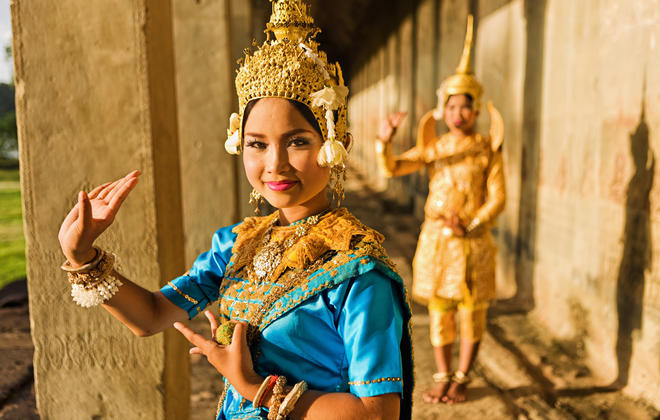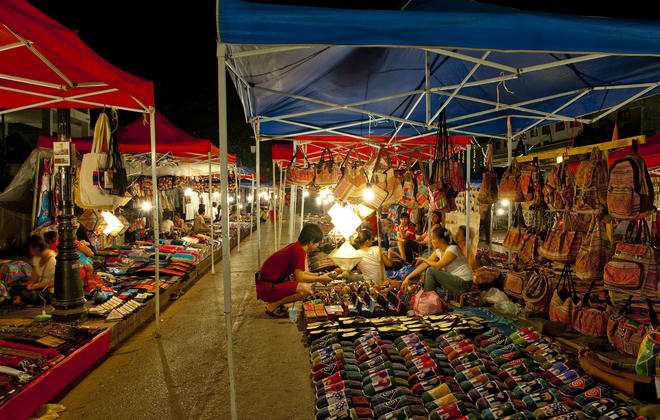Since reopening to tourists in the early 1990s, Cambodia has captivated visitors from around the globe with its rich cultural heritage, warm and welcoming people, and extraordinary natural wonders. Phnom Penh, the nation’s vibrant capital, pulses with energy, offering world-class dining, lively markets, and a spirited nightlife. Yet the country’s true treasures lie beyond the city: the sleepy, French-influenced town of Kampot enchants with its riverside promenade, colonial villas, and charming cafés; the lush, jungle-clad Cardamom Mountains reveal spectacular waterfalls and pristine wilderness; and, of course, the majestic Angkor Wat complex stands as the world’s largest and most breathtaking religious monument. Cambodia seamlessly caters to every traveller, whether seeking exhilarating jungle adventures, serene golden-sand beaches, luxurious resorts, or a journey through its tantalising local cuisine. With its blend of history, nature, and culture, Cambodia remains a destination of endless discovery and wonder.
Situated at the confluence of the Mekong and Tonle Sap rivers, Phnom Penh, Cambodia’s vibrant capital, captivates with its rich history, welcoming locals, and thriving culinary scene. The city’s heritage is immediately evident: the National Museum of Cambodia showcases over a millennium of Khmer art and design, while the monumental Royal Palace—home to King Sihamoni—features the iconic Throne Hall and the dazzling Silver Pagoda, whose floor gleams with five tons of silver. Along the Tonle Sap riverfront, visitors can enjoy refined dining and French-inspired wines, a legacy of the city’s colonial past, while the evenings come alive with lively nightclubs, karaoke performances, and stage shows. Combining culture, history, and cosmopolitan energy, Phnom Penh offers a dynamic and immersive Cambodian experience.





Bangkok, the “City of Angels,” is a spellbinding study in contrasts—one of the world’s most exhilarating capitals, forever reinventing itself while honouring centuries of royal heritage. Home to Thailand’s grand palaces and many of its most sacred temples, the city pairs deep tradition with a bold, forward-looking spirit. It offers some of Asia’s finest hotels, a constellation of glamorous rooftop bars with sweeping skyline views, and a culinary landscape that effortlessly spans award-winning restaurants and some of the most irresistible, affordable street food on earth. A paradise for shoppers, Bangkok delivers everything from high-end luxury malls to curated designer markets, and it has secured its place on the global touring circuit, drawing major international acts and hosting large-scale live performances throughout the year. Its legendary Muay Thai stadiums add a powerful dose of cultural intensity. Yet beyond the glittering high-rises lies a more intimate city: quiet canals, atmospheric Chinatown lanes lined with Michelin-plate eateries, and the tranquil sanctuary of Bang Krachao—Bangkok’s “Green Lung”—where shaded cycling paths and leafy gardens offer a welcome escape. Vibrant, creative and endlessly multifaceted, Bangkok remains one of the most compelling urban destinations in Asia.





Best known as the gateway to the awe-inspiring Angkor Wat temple complex, Siem Reap is a charming town blending French colonial and Chinese architectural influences with a relaxed, welcoming atmosphere. Its crown jewel, the Angkor complex, spans an area larger than Paris and is a labyrinth of intricately carved temples adorned with dancing apsaras, lotus motifs, and five-headed naga (serpent deities). Abandoned for centuries and rediscovered in 1860 by French explorer Henri Mahout, it has since become Cambodia’s cultural and historical highlight. Beyond the temples, Siem Reap offers a vibrant arts and crafts scene, immersive cultural villages that showcase traditional rural life, and a bird sanctuary on the town’s outskirts, providing visitors with a rich mix of heritage, nature, and local culture.





Wedged between a number of larger neighbouring countries, Laos is often overlooked in favour of tourism giants such as Thailand and Vietnam. But these travellers are missing out on an extraordinarily scenic and culturally rich destination. Laos boasts a reputation as the least visited, least Westernised, and most untouched of all Indochinese nations. Only time will tell how long this will last, but while it does, visitors who choose to explore this nation’s remote areas will be richly rewarded. Laos’ primary drawcard is undoubtedly the mighty Mekong River which traverses the length of the country and is considered the second most biodiverse river in the world. In the north, the landscape is characterised by little-explored jungle-clad mountainous areas where visitors can witness the intriguing cultures of the various hill tribes that populate this region. Travellers on the hunt for cultural interest should head for the bustling capital of Vientiane, with its innumerable temples and Buddhist monuments. It is this variety of exotic wildlife, remote wilderness and remarkable cultural treasures that make Laos a truly unique and unforgettable holiday destination.
A charming town with elegant historical architecture and a distinctly French flavour, Luang Prabang in northern Laos is filled with interesting museums, bustling markets and traditional shops. 33 Buddhist temples dot the city.; the Haw Kham Royal Palace Museum and Wat Xieng Thong temple give travellers some background on and history of the Laotian people. Beyond the city, breathtaking nature and ancient sites await. Those who visit the Pak Ou Caves can see hundreds of Buddha statues accumulated there through the ages. The 180-foot Kuang Si Waterfalls, an hour’s drive out of the city, is one of the region’s natural highlights, with its layer upon cascading layer of turquoise pools and torrents.





Vietnam is a land of breathtaking contrasts and sensory delights. It is a country that features everything from exotic culinary delights to breathtaking scenery. Seemingly endless, tranquil rice paddies stand in stark contrast to bustling cities such as Ho Chi Minh City and Hanoi which embrace all the technology and conveniences that the modern world has to offer. The well-preserved colonial buildings of Hoi An play host to a slew of charming boutiques and tempting cafes while, further north, the local hill-tribe people of Sapa sell a wide variety of exquisite crafts and handmade trinkets. Beyond the urban areas, this diverse country is characterised by vast, verdant jungles and lush mountainous regions as well as an enticing coastline peppered with golden sand, palm-lined beaches.
Hanoi, Vietnam’s captivating capital, is a city of contrasts where centuries-old traditions coexist with vibrant urban energy. Its wide boulevards, tree-lined lakes, and ancient pagodas are infused with the elegant legacy of French colonial architecture, creating a uniquely atmospheric backdrop. Visitors can witness synchronized t’ai chi at the serene Hoan Kiem Lake, meander through the bustling Old Quarter with its maze of narrow streets, lively traders, and weaving scooters, or enjoy the whimsical art of water puppetry at the Thang Long Puppet Theatre. Highlights also include the UNESCO-listed Imperial Citadel of Thang Long, the tranquil Perfume Pagoda temple complex, and the stately Hanoi Opera House in the French Quarter. Beyond its historic sites, Hanoi pulses with cafés, markets, and street-side eateries, offering an authentic taste of Vietnam’s culture, cuisine, and daily life—making it a city that charms at every turn.





Ha Long Bay, in northeastern Vietnam, is a breathtaking seascape where thousands of forested limestone islands rise dramatically from emerald waters. A UNESCO World Heritage Site since 1994, its name—“where the dragon descends into the sea”—recalls a legend of a mighty dragon carving valleys and crevasses as it charged toward the coast, leaving only the towering pinnacles visible once the waters rose. Today, the bay can be explored in style via opulent luxury superyachts, traditional Chinese-style junk boats, or even from above aboard scenic seaplane flights, offering unparalleled perspectives of the bay’s islands, hidden caves, and shimmering waters.





Hoi An, on Vietnam’s central coast, is a town steeped in history and timeless charm. Known as Faifo to foreign traders centuries ago, it was a bustling port from the 15th to 19th centuries, attracting merchants from China, Japan, Portugal, and the Netherlands. This rich trading heritage is evident in its eclectic architecture: Japanese merchant houses with curved rooflines, Chinese assembly halls adorned with intricate carvings, and French colonial buildings lining the ancient streets. The town’s canals once carried goods from the Thu Bon River to the sea, facilitating Hoi An’s prominence in regional and global trade. Today, with cars restricted from the main streets, visitors can wander peacefully through its lantern-lit alleys, riverside markets, and temples, while boutique hotels, tailor shops, art studios, and cafés bring the historic port to life. Nearby, the ruins of My Son Sanctuary offer a glimpse into the Cham Kingdom’s Hindu past, complementing Hoi An’s multi-layered history and cultural heritage.





Ho Chi Minh City, Vietnam’s electrifying southern metropolis formerly known as Saigon, brims with a restless energy that’s impossible to resist. The city is a kaleidoscope of sights, sounds, and flavours: the chaotic charm of Ben Thanh Market, where vendors peddle everything from exotic spices and street snacks to tailor-made suits; the leafy oasis of Nha Hang Ngon, serving traditional Vietnamese cuisine in a garden setting; and the lively cafes, rooftop bars, and art galleries that pulse through the districts, offering endless opportunities to soak in the city’s contemporary vibe. History and culture are never far away—admire the neo-Romanesque Notre-Dame Basilica, explore the carved statues at the Jade Emperor Pagoda, reflect at the War Remnants Museum, or visit the rare Taoist sanctuary of Khanh Van Nam Vien Pagoda. From bustling streets and hidden alleys to stylish nightlife and live music, Ho Chi Minh City is a constantly evolving urban playground where every corner offers a new adventure.











